Our top recommendation for an easy, starter houseplant? Pothos, pothos, pothos! They’re low-stress, high-impact, and fast-growing vines that are great for both beginners and experts. The golden pothos may be the most common variety but don’t overlook its more vibrant cousin: the neon pothos. We’ve got several neon pothos in our home, and they’re beautiful and so easy! So here’s all you need to know before you get your own.
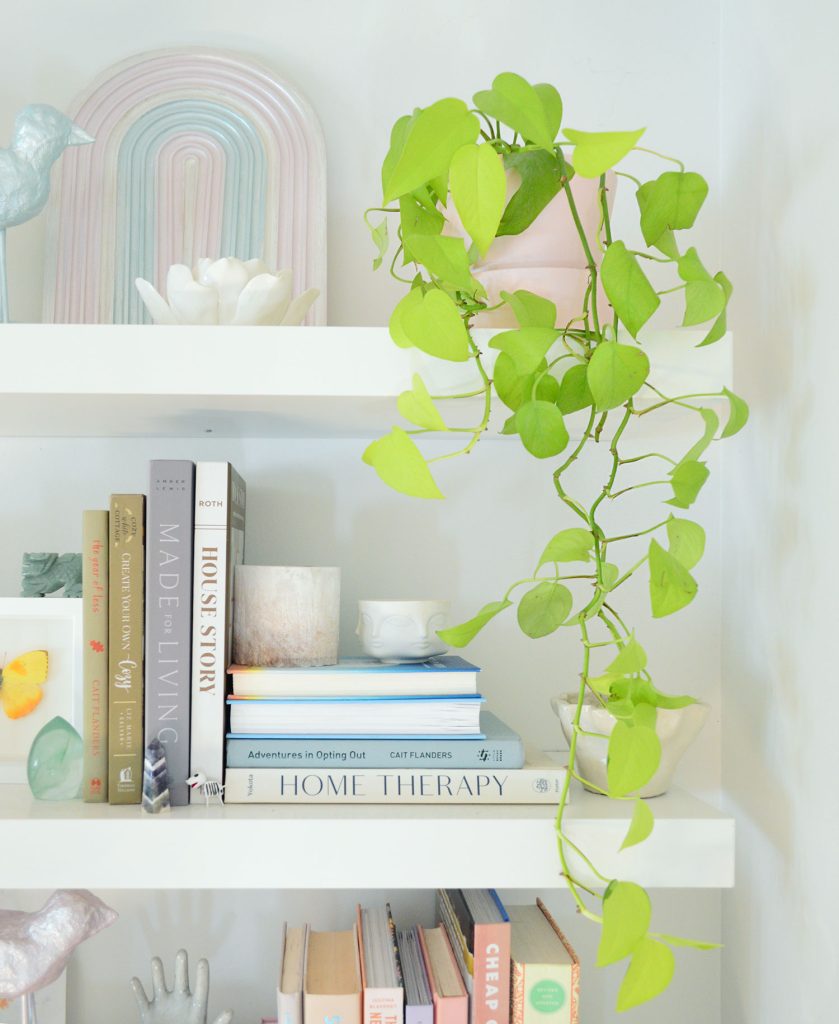
There are over a dozen varieties of pothos, most of which share similar care instructions to the neon pothos. You can read more about other pothos we love, like the golden pothos and marble queen pothos.
Neon Pothos Quick Facts
Here’s what you need to know about your neon pothos at a glance:
- Latin name: Epipremnum aureum ‘Neon’
- Common names: Neon pothos, neon devil’s ivy
- Mistaken for: Golden pothos, lemon lime philodendron
- Light: Prefers bright, indirect light but is low-light tolerant
- Watering: Every 7-10 days during its growing season, or if the soil is dry & leaves are drooping
- Soil: Standard potting mix as long as it drains well
- Ideal Humidity: Average household humidity, ideally 50-70%
- Ideal Temperature: 65-85 degrees
- Cold Hardiness: USDA Zones 10-12
What Is A Neon Pothos?
The neon pothos (Epipremnum Aureum ‘Neon’) is a variety of evergreen vine sometimes called “neon devil’s ivy.” It got this nickname because pothos are pretty hard to kill. Great, right? The “neon” part is an obvious reference to its bright yellow-green leaves. You can see how it compares to the more common golden pothos (which is on the left, below).
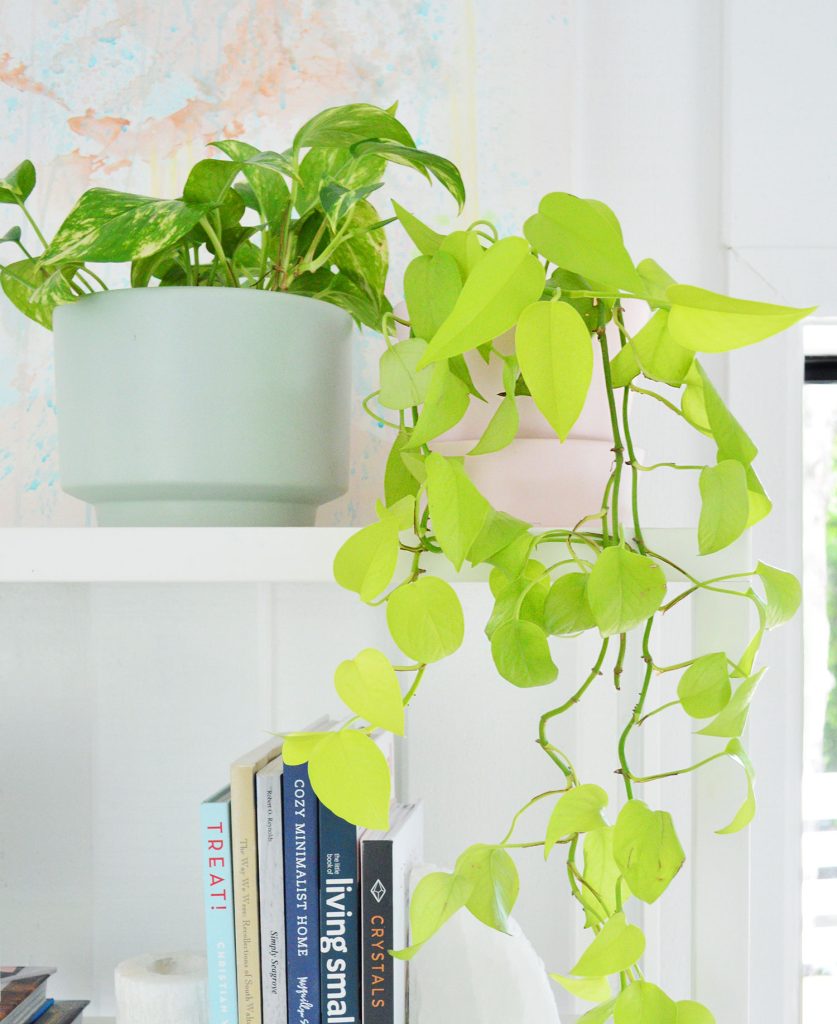
Like other pothos, neon pothos is a vining plant with heart-shaped leaves. They can live in a variety of environmental conditions, and look great potted on a table, hanging in a basket, or trailing off a shelf. We love mixing neon pothos in with our other plants (even other pothos) because its bright leaves add beautiful contrast to our deeper green plants.
Neon Pothos Vs. Golden Pothos
Neon Pothos can easily be mistaken for or mislabeled as golden pothos. This is because all pothos are the same species, but different varieties have been bred over time to create different looks. The leaves of a neon pothos closely resemble the heart-shape of golden pothos and both plants grow to similar sizes. The key difference is the color and patterns on their leaves, as seen below:
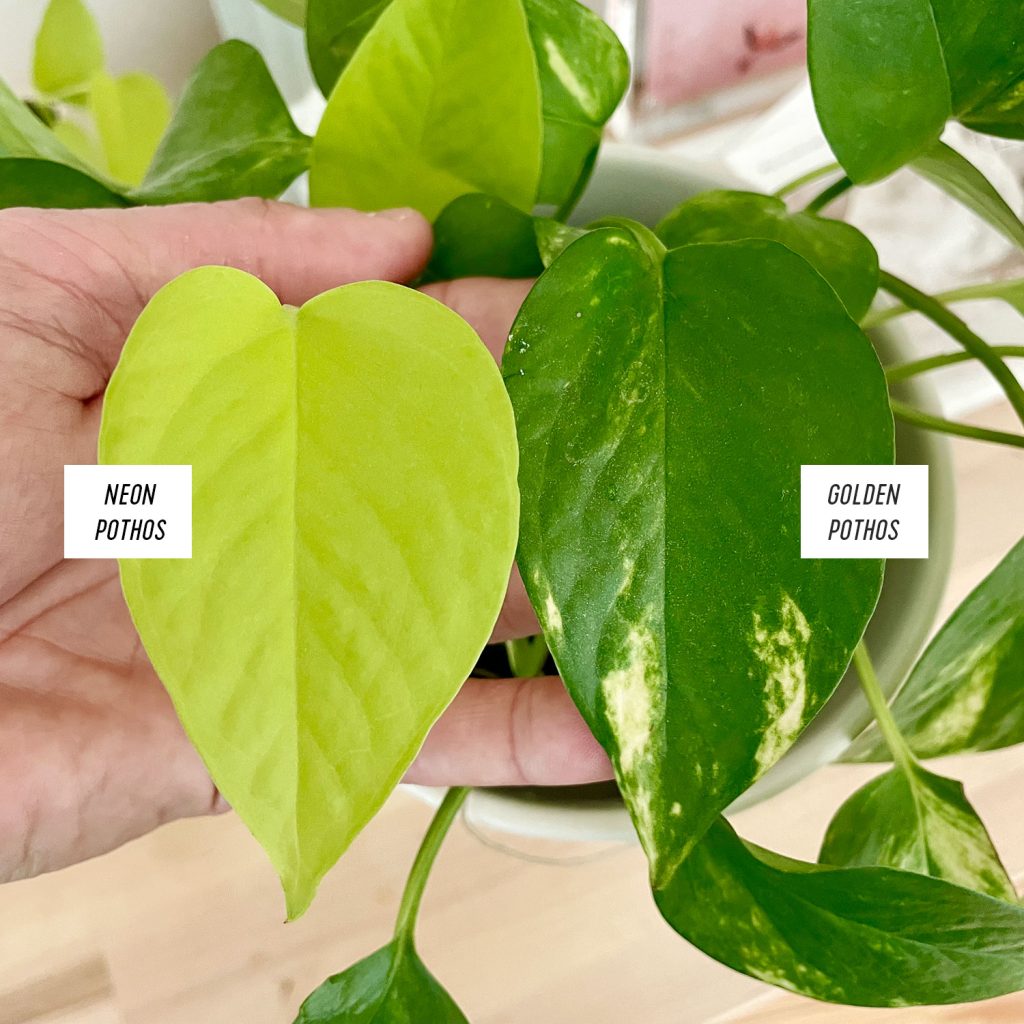
As you can see, neon pothos leaves are a brighter yellower green than golden pothos leaves. Neon pothos leaves are also typically one solid color with no variegation. If you see a yellow or “golden” stripe pattern on your pothos, it’s likely a golden pothos.
These variegations, however, depend on how much light the plant gets, so both varieties may or may not feature some variegation. Also, golden pothos leaves may appear more “neon” when new growth is forming in the spring and summer months. The good news is that both varieties require similar care (and both are super easy), so it’s not important to be 100% sure what variety you own. You can read our golden pothos care guide for more details.
How To Care For A Neon Pothos
Neon pothos can live under many lighting and watering conditions, so you should have no trouble finding a spot for one in your home. We’ve got ours everywhere from low-light corners to bright porches. Here is how to care for yours:
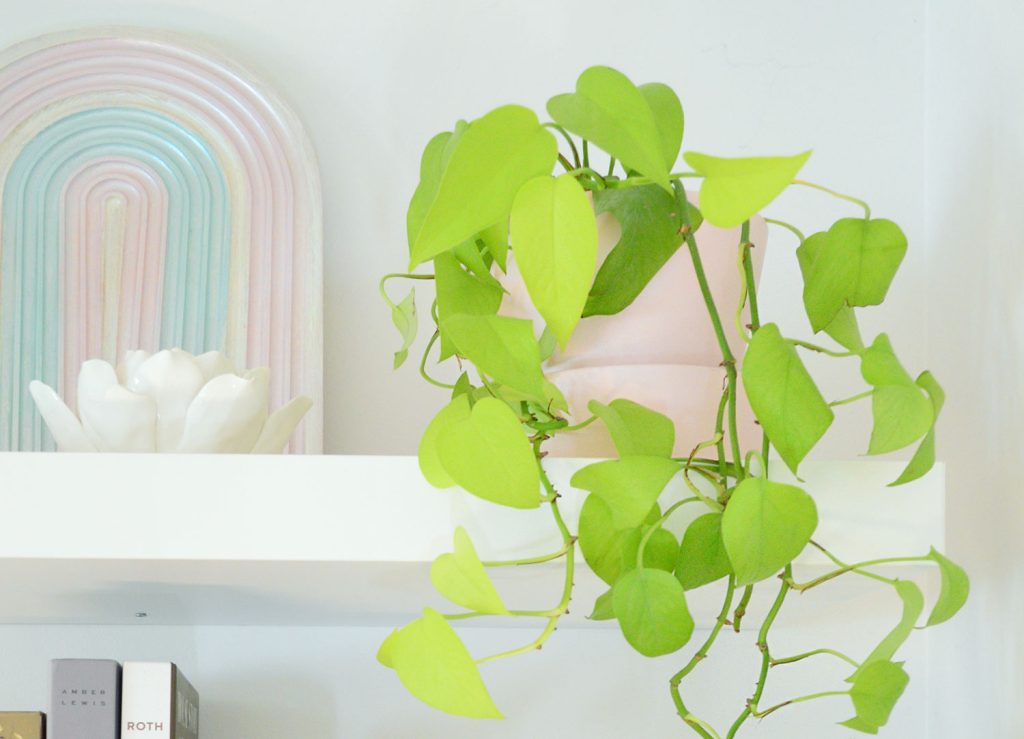
Light
Neon pothos prefer bright indirect light, but they can adapt to many lighting situations and are a great low-light plant. The more sunlight it gets, the brighter its neon color will be. Sufficient sun exposure also encourages fuller, less scraggly growth. We prefer to place pothos in hanging baskets or on shelves where the vines have enough room to hang or drape off an edge.
Water
We typically water our neon pothos every 7-10 days, giving them only a cup or two of fresh tap water. Pothos prefer to be underwatered than overwatered, so try to let the top 2 inches of soil dry out before watering again. Overwatering can cause root rot & yellow leaves. Pothos also tend to droop when thirsty, so you can wait for your plant to signal that it is ready for water.
Soil
Pothos live well in most standard potting mixes, so don’t overthink your soil too much. Overall, they just want well-draining soil so they don’t sit in water. If you want extra credit, mix in some perlite, orchid park, or compost to give them a loose nutritious soil mix.
Pruning
In addition to removing the occasional dead leaf, you can prune your neon pothos to control its shape & size. Pruning is also great for removing leggy vines and encouraging new growth. Use clean sharp scissors to cut anywhere on the vine, preferably 1-2″ below a node (where a leaf meets the stem). Try to leave at least 2-3″ of vine above the soil line.
Repotting
We prefer not to repot our pothos very often, since the process can stress a plant. However, after 1-2 years (depending on its growth rate) you may want to move yours to a slightly larger pot. If you start to see roots growing out of the bottom or top of your current pot, that is a sign the pot has become too small. Make sure there is a drainage hole in the bottom of your pot.
Fertilizer
Pothos aren’t needy and should be fine without regular fertilization. However, if you’d like to give it a boost of nutrients, apply a balanced fertilizer no more than once per month during its spring & summer growing season. These houseplant tablets are easy to drop into your watering can. Just be careful not to overfertilize.
How To Propagate A Neon Pothos
Neon pothos plants are plants to propagate, so try this technique with your stem cuttings. It’s a great way to add new plants to your collection (for free!) or make a gift for a friend.
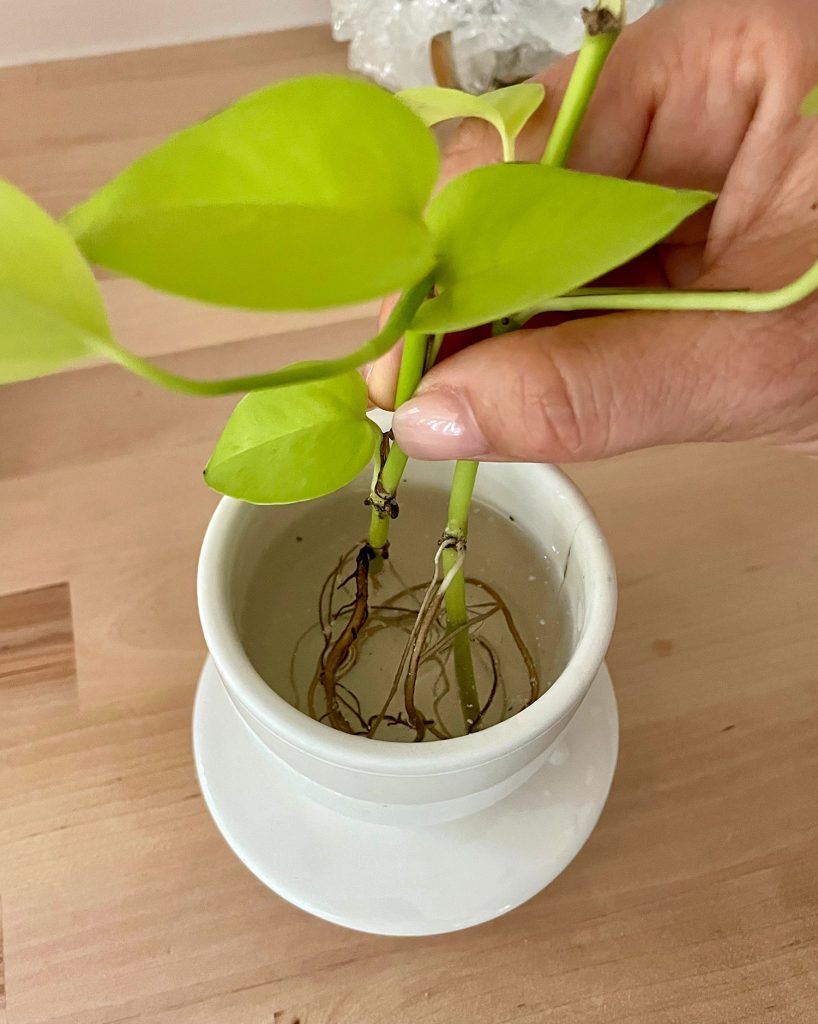
Step 1: Clip off a healthy vine
Use your clean sharp shears to take vine clipping from your neon pothos. We typically cut above a leaf node (where the leaf connects to the vine) and try to leave 3-4 leaves on the mother plant. You can propagate a cut vine as a whole, or cut above and below the individual leaf nodes to propagate multiple leaves separately.
Step 2: Put clipping in water
Fill a clear glass cup, vase, or jar with about 2″ of water. Stick the cut end of your vine in the water, making sure no leaves are submerged. You can remove lower leaves as needed.
Step 3: Place in a bright spot
Find a spot with bright indirect light to place your vessel for a few weeks. Avoid too much direct sunlight. Change the water every 7-10 days. You should see roots starting to appear in the first week or two.
Step 4: Move to soil
We like to let new roots grow a couple of inches before transferring the cutting to a pot with soil. Once that happens, plant your rooted vine in well-draining soil, like a standard potting mix. Water and care for your plant as normal.
Pothos are fast-growing plants, especially went placed in well-lit areas. So propagating them is usually a satisfying experiment that will boost your plant care confidence!
Common Problems
Neon pothos are easy plants, but sometimes they experience common issues seen in all houseplants. Here are some signs your pothos might need some extra care:
- Leaves are dropping: Your pothos is underwatered and needs a drink! Water it like normal and they should perk up within the day.
- Leaves are yellowing: Pothos leaves naturally yellow at the end of their life cycle, so one or two yellow leaves is no cause for concern. Widespread yellowing, however, may indicate overwatering. Reduce your watering schedule or move to better-draining soil.
- Leaves have brown spots or crispy tips: These could be due to underwatering, low humidity, or too much direct sunlight. Try watering or misting your pothos, or move it to a lower-light location.
- Vines are scraggly with few leaves: Your pothos likely needs more light. Try moving to a brighter location, or trim off leggy vines and encourage more growth on top.
- Pests: Pothos don’t tend to have many pest issues, but can see infestations of fungus gnats, mealybugs, spider mites, and more. If you see any insects or webs present they can typically be removed with water and the plant can be treated with a natural neem oil application.
Other Neon Pothos FAQ
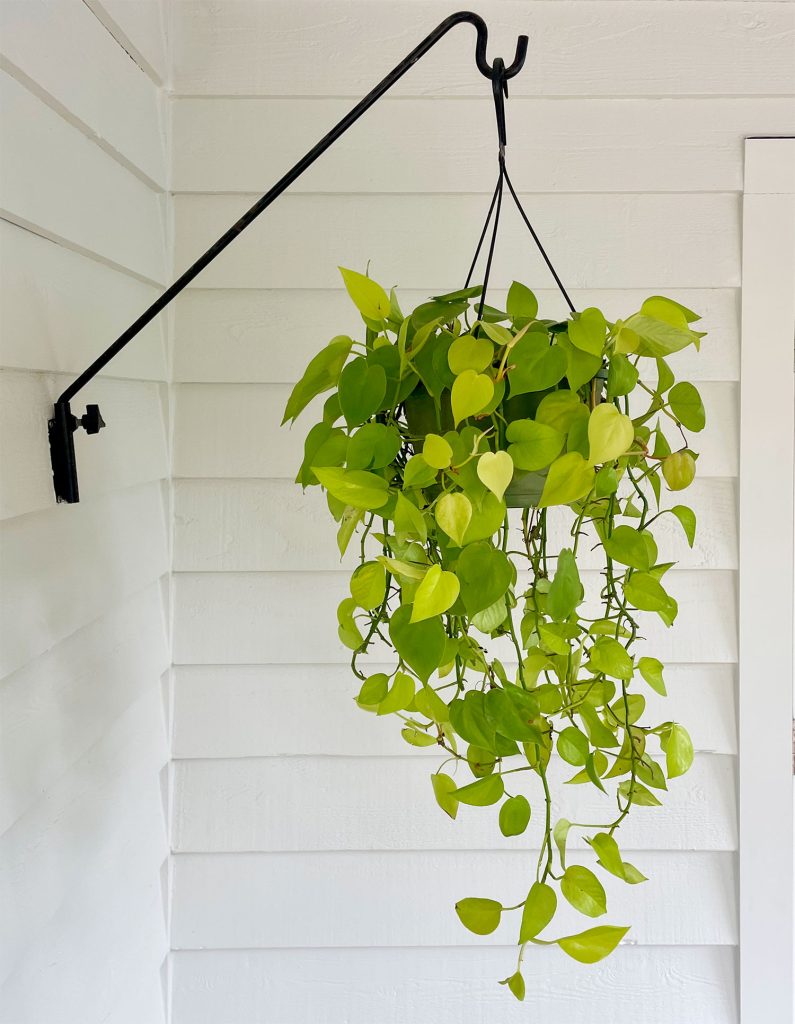
Can Neon Pothos grow outdoors?
Yes! Pothos naturally grow outside in tropical locations, and can survive outside in USDA Plant Hardiness Zones 10-12. If you live in a colder zone, you can also keep your neon pothos outside in the warmer months. Just be sure to place it in a moveable pot that can be brought inside, ideally after temperatures drop below 50 degrees. We do this with a neon pothos that we have hanging in our outdoor kitchen porch.
Are neon pothos toxic to cats?
All pothos plants are toxic to cats, dogs, and humans when ingested. Effects are typically mild, and may include mouth, throat, tongue, skin, or stomach irritation. This is because pothos contain undigestible crystal toxins called calcium oxalates. So if you have a pet or child who might nibble on your pothos, it’s best to keep it out of their reach.
Does neon pothos need more light than other pothos?
Like other pothos, the neon pothos loves lots of indirect light, but can also survive in lower-light situations. There’s no evidence that this particular pothos variety needs more sunlight than others. As always, however, pothos grow faster & fuller when placed in brighter locations.
What other types of pothos are there?
There are more than a dozen varieties of pothos, although neon pothos is one of the more common types. Golden pothos is the most popular, but others include the Marble Queen Pothos, Manjula Pothos, Cebu Blue Pothos, Jade Pothos, Baltic Blue Pothos, and Snow Queen Pothos. Each has a slightly different color, leaf shape, or variegation pattern.
Do pothos hate drafts?
Experts advise keeping houseplants away from drafts like air vents, since they don’t like blasts of hot or cold air. We’ve not personally had trouble with our pothos by an air vent or above our air purifier. We even have several outside that deal with wind! But if you are having trouble with a pothos in a drafty location, consider moving it somewhere else.
More Plant Guides
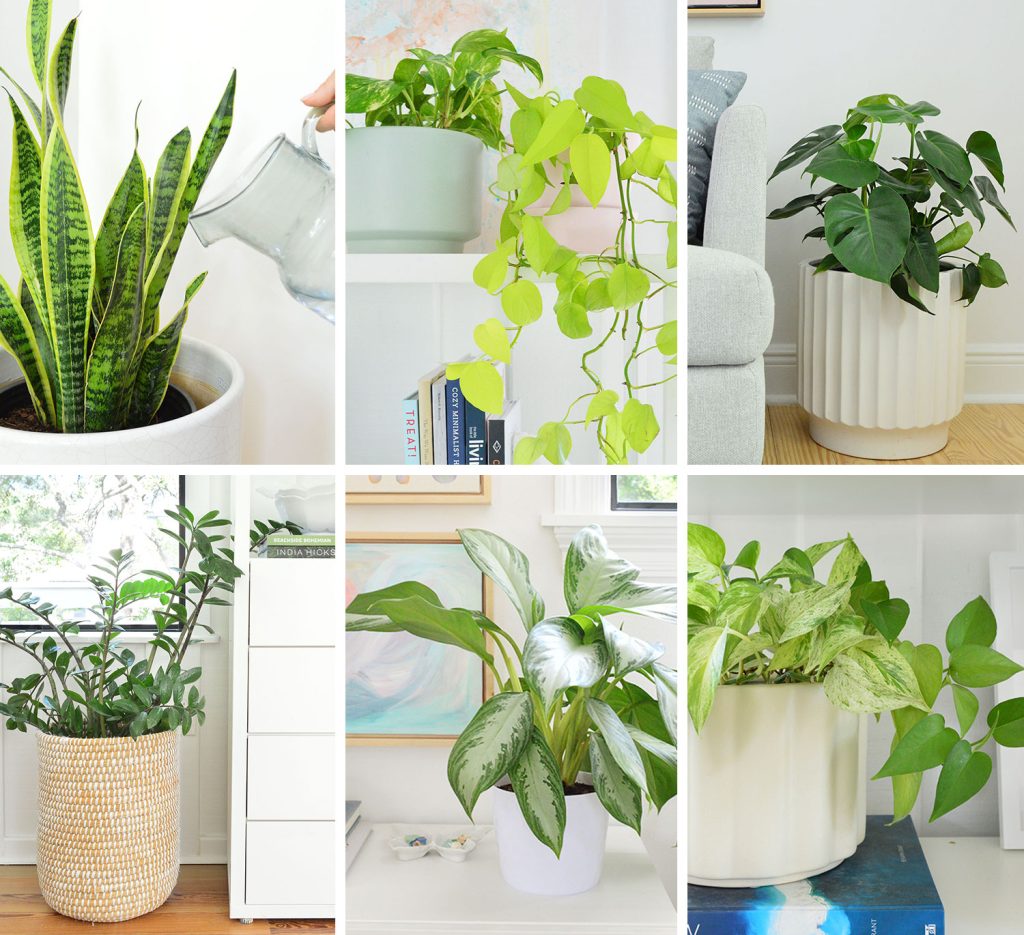
If you’re looking for more information on some of our favorite plants, check out some of these posts below:
- Best Low-Light Houseplants
- Best Air Purifying Indoor Plants
- Golden Pothos Care Guide
- Marble Queen Pothos Care Guide
- Snake Plant Care Guide
- Monstera Deliciosa Care Guide
- Corn Plant Care Guide
- Aglaonema Plant Care Guide
- Fiddle Leaf Fig Care Guide
- Tree Philodendron Care Guide
- How to Build An Easy Plant Shelf
- Make A DIY Wire Trellis
*This post contains affiliate links, so we may earn a small commission when you make a purchase through links on our site at no additional cost to you.
